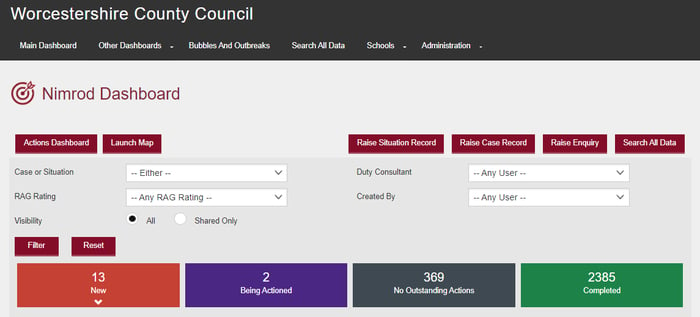Cheaper & faster: Worcestershire's 3-week platform launch
During the pandemic local authorities played a vital role in managing regional outbreaks and supporting an overstretched Public Health England (now UK Health Security Agency). However, faced with an unprecedented situation, most did not have the adequate systems in place.
At Worcestershire County Council, the Public Health and Digital teams came together to rapidly develop a platform that allowed the council and a neighbouring local authority to successfully control Covid-19 outbreaks. Two executives involved in the project tell Government Transformation how they did it - and how they saved 80% of the likely cost of an off-the-shelf alternative.
Nimrod: Creating a Covid response management platform
Before Covid-19 hit, Worcestershire County Council was not regularly involved in operational work relating to health protection issues, as these would fall under the responsibility of the Public Health England (PHE), the executive agency part of the Department of Health and Social Care which in October 2021 became the UK Health and Security Agency.
However, this changed with the pandemic, when an overstretched PHE lacking capacity asked local authorities for help to manage local Covid outbreaks.
Because this was new territory for Worcestershire, at first the council used Excel spreadsheets to keep track of Covid cases. It was soon clear that this method was time-consuming and ineffective, so the Public Health and IT and Digital teams came together to think of a more sustainable solution.
The solution was called Nimrod: an in-house developed cloud-based system able to record and document decisions and actions taken about outbreaks to support the work of the Local Outbreak Response Team (LORT)..jpg?width=220&name=WIN_20211208_12_13_06_Pro%20(3).jpg)
“When Covid hit, we had no platform to work with, spreadsheets were the way to work: Nimrod aimed to solve that,” says Matthew Fung, Consultant in Public Health at Worcestershire County Council. “Nimrod was trying to solve this plethora of unlinked, risky spreadsheets that were effectively being used as micro databases without or with little structure and data integrity behind it.“
The council has a robust digital transformation programme but Nimrod was given the highest priority as a vital piece supporting the Covid response. The main difference between this project and previous ones is that in this case there was not a process to follow. This is why close collaboration between the Public Health and Digital teams was essential to understand what the requirements were and how to best deliver them.
“I think it helped that I could speak a similar language to the developers,” Fung adds. “That helped to align what we wanted and how the development took place.”
The development of the platform began in June 2020. By July 2020, the first version was already up and running. The Covid vaccine was not yet available at the time and the local authority was working against the clock to contain the spread and prevent more people from dying or falling severely ill.
“It was like we were building an aeroplane whilst we were in flight,” Fung tells Government Transformation.
Collaboration: The key to Nimrod’s success
The Digital team already had strong foundations in place that supported the fast delivery of the in-house platform, including established agile ways of working which enabled the team to develop Nimrod very quickly, explains Jo Hilditch, Head of Digital, Data and Web Services at Worcestershire County Council.

“Within the team, we’re fortunate enough to have some highly-skilled digital developers and business analysts,” Hilditch says. “We’re able to analyse what the need is and quickly turn that into development.”
The severity of the situation, with Covid response teams working non-stop seven days a week, prevented extensive testing and a planned migration to Nimrod. The pressing need to have a system in place to manage the outbreak meant that teams were migrated to the new system instantly.
“Anything that was Covid-related got shifted to high priority within the digital transformation programme,” Hilditch adds.
Using a low code platform, two developers in Hilditch’s digital team created a bespoke database within three weeks. It was integrated with a geographic information system that allowed the capture of geolocation data and SQL Server Reporting Services for the creation of real-life reports that could give insights into the patterns and trends in case rates.
Once launched, Nimrod allowed Worcestershire County Council to have a consistent way of documenting information, have an auditable history and see the time and date of the records’ entries. The platform also supports the attachment of documents relating to an outbreak - all following data privacy regulations and requirements.
Through Nimrod, staff could see the most up-to-date information relating to an outbreak and provide a timely and consistent response to stakeholders and professionals seeking advice and guidance from the LORT team.
Nimrod could be used by multiple organisations at a time. In this case, it was also used by Herefordshire County Council to manage Covid outbreaks in their local authority.
One of the main benefits of Nimrod is that it allowed the council to develop and adapt the system in response to the changing Covid guidance, operational framework and user feedback. The use of low code meant that changes could be made quickly as needed.

Providing secure access to data through the platform was essential and although there were initially some challenges around it, Hilditch says that they were successfully overcome. Low code proved again useful to make changes as Covid rules continued to change .
“We work very closely with colleagues around security and we have an Enterprise Architect that makes sure that everything is okay from a security perspective,” Hilditch says. “We also work very closely with colleagues around data protection and privacy statements so that we have all of the right governance in place around sharing data.”
Nimrod 2.0: What comes next?
Subsequent iterations to Nimrod added new features such as integrated text messaging, mass importing of spreadsheet data and epidemiological reporting.
Fung adds that if the platform had been outsourced, the cost and time spent on it would have been significantly higher: “Other local authorities bought commercial systems, paying huge sums of money for the system alongside annual subscription fees. Our estimate is that Nimrod cost around 20% of commercial costs by doing internal development for a single system. We also saved that times two because Herefordshire used Nimrod as well.”
The success of Nimrod and the teams behind it did not go unnoticed. In March, Worcestershire County Council was given the silver award for ‘Best use of Digital and Technology’ at the Public Sector Transformation Awards 2022.
Hilditch and Fung say that the Council is now redeveloping the model to create a second version of the platform that can have other uses beyond Covid contact tracing, including management of other viral outbreaks.
They also hope that the teamwork and collaboration seen throughout the creation of Nimrod will continue to empower teams across their organisation and unlock opportunities for innovation within the council.





